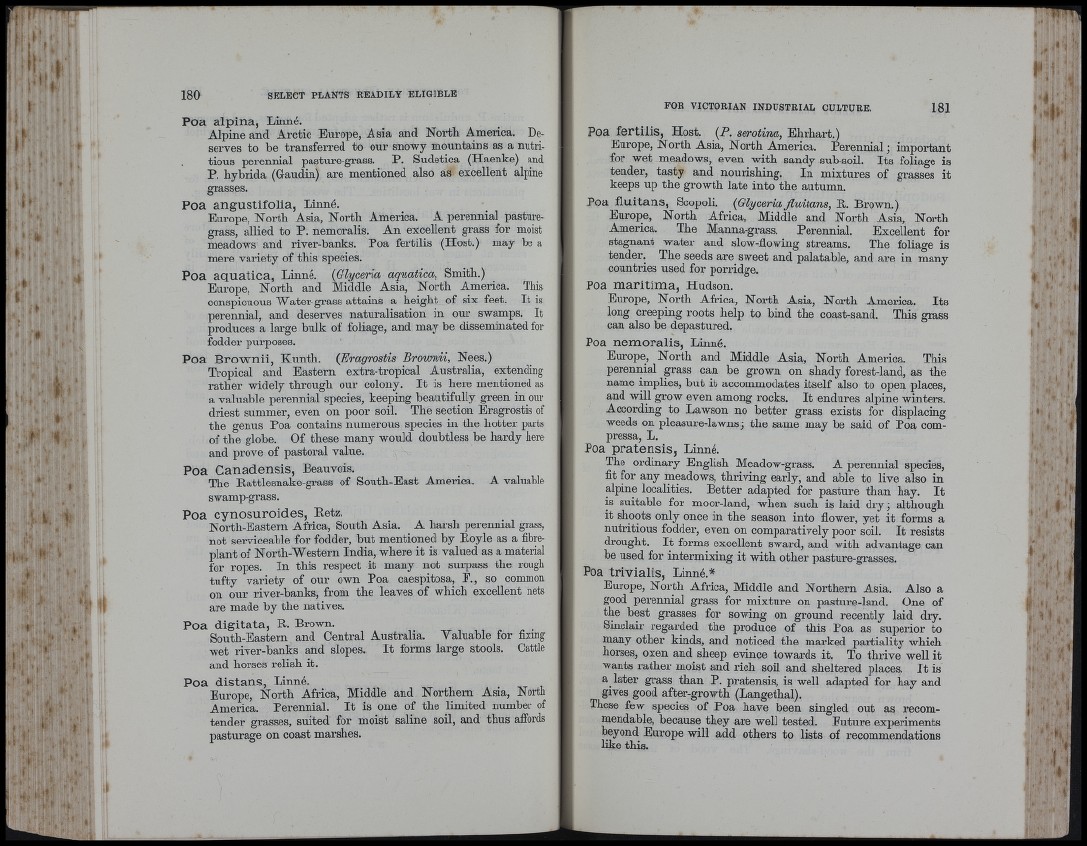
* lrít
Poa alpina, Linné.
Alpine and Arctic Europe, Asia and North America. Deserves
to be transferred to onr snowy mountains as a nutritious
perennial pasture-grass. P. Sudetica (Haenke) and
P. hybrida (Gandin) are mentioned also as excellent alpine
grasses.
Poa angustifolia, Linné.
Europe, North Asia, North America. A perennial pasture-
grass, allied to P. nemoralis. An excellent grass for moist
meadows and river-banks. Poa fertilis (Host.) may be a
mere variety of this species.
Poa aquatica, Linné. (Glyceria aquatica, Smith.)
Europe, North and Middle Asia, North America. This
conspicuous Water-grass attains a height of six feet. It is
perennial, and deserves naturalisation in our swamps. It
produces a large bulk of foliage, and may be disseminated for
fodder purposes.
Poa Brownii, Kuntb. (Eragrostis Broumii, Nees.)
Tropical and Eastern extra-tropical Australia, extending
rather widely through our colony. I t is here mentioned as
a valuable perennial species, keeping beautifully green in onr
driest summer, even on poor soil. The section Eragrostis of
the genus Poa contains numerous species in the hotter parts
of the globe. Of these many would doubtless be hardy here
and prove of pastoral value.
Poa Canadensis, Beauvois.
The Battlesnake-grass of South-East America. A valuable
swamp-grass.
Poa cynosuroides, Betz.
North-Eastern Africa, South Asia. A harsh perennial gi’ass,
not serviceable for fodder, but mentioned by Royle as a fibre-
plant of North-Western India, where it is valued as a material
for ropes. In this respect it many not surpass the rough
tufty variety of onr own Poa caespitosa, E., so common
on onr river-banks, from the leaves of which excellent nets
are made by the natives.
Poa digitata, R. Brown.
South-Eastern and Central Australia. Yaluable for fixing
wet river-banks and slopes. I t forms large stools. Cattle
and horses relish it.
Poa distans, Linné.
Europe, North Africa, Middle and Northern Asia, North
America. Perennial. I t is one of the limited number of
tender grasses, suited for moist saline soil, and thus afibrds
pastm-age on coast marshes.
Poa fortilis, Host. {P. serótina, Ehrhart.)
Europe, North Asia, North America. Perennial; important
for wet meadows, even with sandy sub-soil. Its foliage is
tender, tasty and nourishing. In mixtures of grasses it
keeps up the growth late into the autumn.
Poa fluitans, Scopoli. {Glyeeria fluitans, R. Brown.)
Europe, North Africa, Middle and North Asia, North
America. The Manna-grass. Perennial. Excellent for
stagnant water and slow-fiowing streams. The foliage is
tender. The seeds are sweet and palatable, and are in many
countries used for porridge.
Poa maritima, Hudson.
Europe, North Africa, North Asia, North America. Its
long creeping roots help to bind the coast-sand. This grass
can also be depastured.
Poa nemoralis, Linné.
Europe, North and Middle Asia, North America. This
perennial grass can be grown on shady forest-land, as the
name implies, but it accommodates itself also to open places,
and will grow even among rocks. I t endures alpine winters.
According to Lawson no better grass exists for displacing
weeds on pleasure-lawns; the same may be said of Poa compressa,
L.
Poa pratensis, Linné.
The ordinary English Meadow-grass. A perennial species,
fit for any meadows, thriving early, and able to live also in
alpine localities. Better adapted for pasture than hay. I t
is suitable for moor-land, when such is laid dry; although
it shoots only once in the season into flower, yet it forms a
nutritious fodder, even on comparatively poor soil. I t resists
drought. I t forms excellent sward, and with advantage can
he used for intermixing it with other pasture-grasses.
Poa trivialis, Linné.*
Europe, North Africa, Middle and Northern Asia. Also a
good perennial grass for mixture on pasture-land. One of
the best grasses for sowing on ground recently laid dry.
Sinclair regarded the produce of this Poa as superior to
many other kinds, and noticed the marked partiality which
horses, oxen and sheep evince towards it. To thrive well it
wants rather moist and rich soil and sheltered places. I t is
a later grass than P. pratensis, is well adapted for hay and
gives good after-growth (Langethal).
These few species of Poa have heen singled out as recommendable,
because they are well tested. Future experiments
beyond Europe will add others to lists of recommendations
like this.